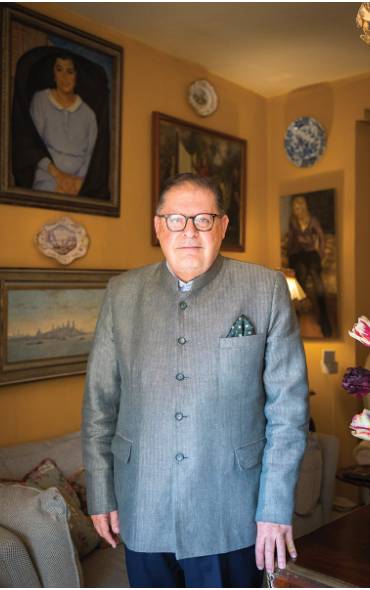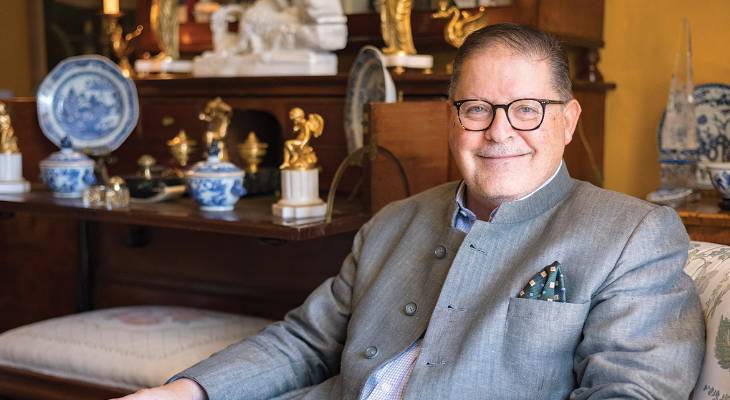Artist and founder of the Valletta International Baroque Festival, Kenneth Zammit Tabona shares his unique insight into Malta’s artistic soul. In this interview with Sarah Muscat Azzopardi, he reflects on his creative world, deep ties to Maltese heritage, and the enduring power of art.
Walking into Kenneth Zammit Tabona’s vibrant St Julian’s apartment on a sunny spring morning feels very much like stepping directly into one of his celebrated watercolours. A visual assault in the best sense, with all manner of antique furniture, ceramics, art, and decorative items arranged with intent, each lovingly polished and displayed – it makes for a welcome respite from the bustling world outside, as well as an intriguing tableau that is only fitting for an artist of Kenneth’s calibre.

Inigo Taylor
In the distinct tapestry of Malta’s cultural scene, few threads are woven as intricately or as colourfully as those belonging to Kenneth. As an artist, illustrator, founder of the Valletta International Baroque Festival, ex-artistic director of the Teatru Manoel, and champion of Malta’s musical heritage, his roles are diverse, and upon meeting him, I immediately sense a profound connection not just to creativity, but to the very soul of this island nation.
Born in 1956 and educated at St Aloysius College, Kenneth’s career path initially led through the world of banking before his passion for the arts took centre stage. Going on to review music and theatre for prominent local publications, he served extensively on the Manoel Theatre management committee, yet it’s the interplay between his own visual art and his dedication to music that perhaps defines him most uniquely.
“How do these different art forms influence each other in your creative process?” I ask, early in our discussion, curious about the synergy between his instantly recognisable watercolours and his musical endeavours.
“That’s a bit of a difficult one,” he muses, settling back into his chintz armchair. “I suppose art in all forms is basically part of my DNA,” he continues, explaining that for him, the connection is intrinsic, almost synesthetic. “Both music and the visual arts, to me, are interlinked. What I mean is that sometimes, I see music, I don’t just listen to it. I don’t know what I see, but I do see. It’s a very strange thing to explain.” Kenneth elaborates, citing modern art movements: “when you think of Kandinsky’s and Pollock’s work, and that sort of abstract painting… a lot of it translates into music for me. A lot of painting translates into music, and vice-versa.”
This provides an interesting lens with which to view his watercolour work, known for capturing Malta’s essence through strong colours and distinctive shapes, whether depicting landscapes, urbanscapes, or interiors. His paintings often feature what he calls fuori dentro – a term coined by the late Professor Peter Serracino Inglott – depicting interior scenes looking out onto a Maltese view.
“They are still lives featuring Chinese porcelain and beautiful, continental furniture, not just Maltese furniture... but somehow they’ve got a very Maltese flavour,” Kenneth describes, musing on how he populates these scenes with personal motifs – like arum lilies in spring (“I’m very seasonal!”), a recurring flying blue bird, and almost invariably, a small red ball.
He traces the origin of the red ball back to a lithograph he owned years ago. “This red ball always sort of, haunted me. And somehow, I need this red ball. I don’t know what it is. I feel it anchors my paintings,” he smiles, mysteriously.

Michaele Zammit
Turning our attention to the musical side of his journey, Kenneth’s passion for the arts extends deeply into Malta’s rich Baroque heritage. He is the founder and artistic director of the prestigious Valletta International Baroque Festival, established in 2012, which showcases leading international ensembles alongside local talent in Malta’s stunning Baroque locations; and has also founded the Valletta Baroque Ensemble and The Monteverdi Project to champion works by 17th- and 18th-century Maltese and Italian composers associated with the Order of Malta and the Episcopate, many connected to the Naples Bourbon Court.
“Could you share a hidden musical gem from Malta’s history that more people should know about?” I inquire. Kenneth immediately highlights Geronimo Abos, a composer with a Maltese mother and Italian father.
“His Stabat Mater is a meditation of Our Lady sitting at the foot of the cross,” he explains, noting its beauty and the parallels with Giovanni Battista Pergolesi, Abos’s contemporary in Naples, going on to reveal exciting upcoming plans: “next January (2026), we are presenting for the first time, probably since the 18th century, an opera by Geronimo Abos called Il Pelopida, based on a Greek myth – this is something that nobody’s ever heard. It’s a completely new revival.”
This dedication to unearthing forgotten treasures is central to the festival’s ethos, he states, affirming, “the raison d’être of the festival was also to revive music which has been lying in archives for years.”
On the subject of opera, Kenneth’s connection to the Teatru Manoel, Malta’s national theatre, where he served as Artistic Director from 2014 to 2023, is palpable. He describes it not just as a venue, but as a focal point. “The Manoel is part of my life,” he affirms. “It is the vortex, the focal point... of what the arts mean to me.”
Comparing it to other historic European theatres, he notes its unique character. “How did theatre evolve?” he posits. “Theatre, along with Baroque music, evolved to house opera.” He explains that the Manoel, though smaller than giants like La Scala or San Carlo, embodies the intimate court theatre design. “The boxes were designed for theatre goers to see and be seen,” Kenneth smiles, adding that the exquisite Neapolitan decorations further enhance the charm.
Beyond specific venues, Kenneth sees Malta itself as inherently artistic. “Malta is a cultural hub in its own right,” he asserts, pointing to the local feasts as prime examples. “Our feasts are an extraordinary feature in themselves – the statues, the banners, the swags of flowers – an incredibly Baroque expression. They reflect who we are.”

Inigo Taylor
He believes this artistic spirit stems from Malta’s history as a crossroads of civilisations, particularly the era of the Knights of St John (1530-1798). “We were lucky,” he says, explaining how the island became home to scions of Europe’s most important families. Indeed, the Knights’ decision to stay after the Great Siege of 1565, led by Grandmaster La Valette, cemented Malta’s destiny and led to the building of Valletta. This influx created a unique melting pot. “A glance at today’s Maltese surnames reveals a tapestry woven from names across the globe. That’s when the rich diversity of the Maltese genetic makeup comes to light.”
Ultimately, for Kenneth, art in all its forms is not merely decorative, but essential. He champions accessibility and decries artistic snobbery. Citing universally loved works like the Mona Lisa or Tchaikovsky’s Piano Concerto No. 1, he counters the idea that popularity diminishes value. “Art should be an open book,” he insists. “It is not for the high priests. It is for everybody to enjoy.”
The artist goes on to share his belief that art connects us to something profound, echoing Dante: “Art is God’s grandson... God created man, and man created art.” In today’s often fraught world, he sees art as a vital force. “Music and art will save us all,” he states passionately. “There’s hope that there is still beauty, there is still civilisation... that is why we are here. To me, it is the closest we can come to spirituality.”
This article first appeared on Guide Me 2025.